Embarking on the journey towards your desired height is a thrilling and rewarding pursuit. Just as a sturdy building requires a solid foundation to stand tall, achieving your ideal height involves a blend of crucial elements working in harmony. Among these, engaging in height-promoting sports, maintaining a balanced diet, and ensuring ample rest emerge as vital components of this endeavor.
Sports, in particular, play a pivotal role not only in enhancing overall health but also in fostering height development. They offer an excellent avenue to improve physical fitness and stimulate bone growth plates. Interested in discovering which sports are most effective in aiding height increase? You’re in luck! An illuminating piece on heightgrowthtip.com provides all the insights you need.
Within this article, we’ll delve into the link between sports and height augmentation, explore the science underpinning these activities, and uncover optimal sports practices to support your height growth journey. So, let’s strap on those sneakers and prepare to elevate ourselves physically and mentally. The road to your desired height beckons, and it starts with recognizing the crucial role of sports in your pursuit
Basketball
In the late nineteenth century, in the quaint town of Springfield, Massachusetts, a new sport was born. Little did anyone know that this game, known as basketball, would go on to captivate the hearts of athletes and enthusiasts worldwide, becoming a global phenomenon. Over the course of nearly half a century, basketball evolved from a simple pastime into an Olympic discipline, and its impact on the world of sports cannot be overstated.
Basketball is a game played on a rectangular court, where two teams, each comprising five players, compete with the goal of amassing the most points. Victory hinges on not only skill but also strict adherence to the rules of the game. In the event of a tie, the teams engage in thrilling overtime play, adding an extra layer of excitement to the sport.
One of the defining characteristics of basketball is the significance of height. In this sport, height often translates to a significant advantage. The center position is typically occupied by the tallest player, using their height to dominate near the basket. The power forward combines height and strength, while the small forward stands a bit shorter but remains agile and versatile. The shooting guard excels in ball handling and shooting, while the point guard orchestrates the team’s strategies and playing style, serving as the on-court leader.
On the global stage, the NBA (National Basketball Association) stands as the pinnacle of professional basketball in North America. It boasts a constellation of skilled and celebrated players, captivating audiences with their extraordinary talent and athleticism.
In Vietnam, basketball has found a home and surged in popularity among the youth since its introduction in the mid-twentieth century. It has become a common fixture in educational institutions, from junior high schools to universities, attracting aspiring athletes and enthusiasts alike. The game’s allure continues to grow, drawing young talents into its competitive embrace.
Engaging in basketball training offers a multitude of compelling health benefits. The dynamic nature of the sport, characterized by rapid movements, constant direction changes, and intense muscle contractions, fosters the development of robust and resilient muscles. This is particularly beneficial for individuals looking to increase their muscle strength.
Furthermore, basketball’s high-intensity demands contribute to improved bone health, leading to stronger bones compared to those who lead a more sedentary lifestyle. The sport’s emphasis on precision and agility also cultivates superior coordination and agility in players.
From a cardiovascular perspective, basketball training is an effective means to enhance fitness levels, reducing the risk of cardiovascular diseases through regular physical activity. Additionally, the sport serves as a natural stress reducer, triggering the release of endorphins, which promote relaxation, well-being, and stress reduction, ultimately contributing to improved mental health.
For young athletes, basketball’s frequent jumping, catching, passing, and shooting stimulate cartilage development and foster bone growth. The high-frequency movements and speed of the game also promote flexible and strong leg joints, which are advantageous for overall bone health.
Incorporating basketball into one’s routine from a young age is advisable for honing essential skills effectively. Outdoor basketball training provides an added benefit by exposing participants to sunlight, facilitating vitamin D synthesis, supporting efficient calcium absorption for bone health, and further promoting height growth.
In conclusion, basketball is more than just a sport; it’s a cultural phenomenon with deep roots in Springfield, Massachusetts, and a global impact. Its blend of athleticism, strategy, and health benefits make it a favorite among both players and fans. So whether you’re a towering center or a nimble point guard, basketball offers a world of opportunities for growth, on and off the court.

Volleyball
Volleyball, with its origins tracing back to late 19th-century America, has transcended its status as a mere sport to become a dynamic team endeavor that ignites passion and offers a multitude of health benefits. For many, volleyball is more than just a game; it’s a pathway to physical excellence and overall well-being.
Within the realm of volleyball, players assume distinct positions, each with unique responsibilities. The setter, often referred to as the orchestra conductor of the team, coordinates offensive moves with precision. The libero, the unsung hero, specializes in defensive maneuvers and plays a crucial role in the team’s performance. Middle blockers serve as imposing sentinels at the net’s edge. Outside hitters are the heartbeat of the team’s offense, while opposites hold down the fort on the defensive front under the net.
Participating in the sport of volleyball is not merely a pastime; it’s an avenue to attain physical prowess, improved coordination, and cardiovascular fitness. Beyond these tangible benefits, volleyball has been known to contribute positively to height development, making it a favored choice for those aspiring to enhance their stature.
Volleyball offers a plethora of remarkable advantages that extend far beyond the volleyball court, enriching overall health and well-being in various ways:
- Calorie Incineration: Volleyball isn’t just a game; it’s a calorie-burning powerhouse. Engaging in this sport entails constant motion and high-intensity workouts that effectively torch calories. It’s a fantastic tool for shedding excess weight, maintaining an optimal physique, and sculpting a toned body.
- Sharpened Reflexes: The lightning-fast pace of volleyball demands lightning-quick decision-making and lightning-precise reactions. Players must decipher the ball’s trajectory and anticipate its landing point in the blink of an eye. Regular volleyball practice sharpens reflexes, enabling split-second, agile judgments in high-pressure situations.
- Fortified Bones: Volleyball’s dynamic nature, characterized by perpetual movement and action, contributes to a supple body. The frequent changes in posture during the game promote smooth joint functionality and serve as a barrier against various osteoarthritis conditions. In essence, volleyball is a sport that strengthens not only muscles but also the very framework of your body.
- Stress Alleviation: Volleyball is more than just a sport; it’s a mental sanctuary. Playing as part of a team demands unwavering focus and concentration. When on the court, players temporarily cast aside the fatigue and stress of daily life, immersing themselves wholly in tracking the ball’s trajectory. Many individuals turn to volleyball as a potent stress-reliever, especially during taxing periods such as exams or work-related pressures.
- Height Enhancement Catalyst: Volleyball’s signature moves involve jumping to catch, pass, and block the ball. This dynamic aspect of the game stretches the joints in the back, legs, and hips. These stretching motions stimulate cartilage growth, encourage the formation of new bone tissue, and accelerate height development. Simultaneously, they fortify the skeletal system, ensuring robust and enduring support.
In conclusion, if you aspire to enhance your height and embrace a sport that offers an all-encompassing package of physical and mental benefits, volleyball undoubtedly stands out as a worthy contender. Volleyball is not just a game; it’s a journey towards a healthier, more agile, and taller you. So, grab a ball, gather your friends, and start spiking your way to a healthier and taller future.
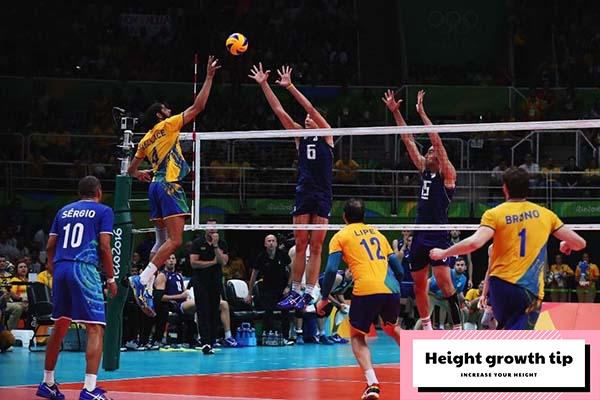
Swimming
Swimming, the art of propelling oneself through water without artificial assistance, is a practice that transcends time and serves as a vital survival skill, a professional pursuit, and a source of relaxation and enjoyment. With a history dating back to prehistoric times, swimming has evolved into a prominent sport, offering a plethora of benefits to individuals of all ages and skill levels.
Evidence of swimming’s ancient roots can be traced back to Stone Age paintings from around 2000 BC, a testament to its enduring appeal throughout human history. Over time, it has transformed into a prominent sport featured in various large and small-scale sporting events worldwide.
Modern swimming encompasses a variety of styles, each with its unique characteristics and techniques. The most popular swimming styles practiced today include the freestyle (also known as the front crawl), breaststroke (often likened to frog swimming), butterfly stroke, and backstroke. Swimmers often choose a style that suits them best to maximize speed and efficiency in competitions.
Beyond the competitive arena, swimming offers a wide range of physical and mental benefits. It serves as a full-body workout, toning muscles, increasing strength, enhancing endurance, and elevating heart rate without excessive stress on the body. Moreover, swimming contributes to overall health by benefiting the cardiovascular system, helping control blood pressure and blood sugar levels, and reducing the risk of various health conditions.
Swimming’s low-impact nature makes it an ideal choice for individuals recovering from accidents or experiencing joint pain, offering relief and aiding in the recovery process. It is also beneficial for those with asthma, as it involves breathing exercises that improve lung capacity and control.
For those seeking to manage their weight, swimming is an effective calorie-burning activity. Furthermore, it promotes better sleep by expending energy, reducing stress levels, and relaxing muscles and bones, leading to improved sleep quality and enhanced mood.
One intriguing aspect of swimming is its potential impact on height growth. Swimming techniques, involving arm movements and kicking, exert greater pressure underwater than land-based activities. This pressure may stimulate bone growth, potentially contributing to height increase. Introducing children to swimming lessons at a young age and encouraging regular practice during puberty may facilitate rapid height growth.
Before diving into the pool, it is advisable to have a light meal to ensure optimal exercise effectiveness and prevent potential injuries. Choosing the right swimwear, made of stretchable materials and offering comfort and ease of movement, can enhance the training process.
For those looking to harness the benefits of swimming, practicing at designated swimming training centers under the guidance of a coach is recommended. Swimming in pools is generally safer and more secure compared to natural bodies of water.
In conclusion, swimming is a time-honored practice that continues to enrich our lives today. Whether for survival, competition, or leisure, the benefits of swimming are as vast and deep as the waters themselves, offering a holistic approach to physical and mental well-being.

Diving
In the world of adventure sports, one activity has been making waves – quite literally – and capturing the hearts of enthusiasts around the globe. Scuba diving, with its mesmerizing underwater landscapes and encounters with marine life, has rapidly grown in popularity. While it may not hold the secret to gaining a few extra inches in height, scuba diving offers a treasure trove of physical and personal rewards that can enrich your life in ways you might not expect.
Before we delve deeper into the world of scuba diving and its manifold benefits, let’s take a moment to unpack the essential equipment needed for this thrilling underwater endeavor. The scuba diving gear arsenal includes the scuba itself, an apparatus that delivers compressed air for breathing beneath the surface, along with fins to provide efficient propulsion. A diving mask enhances visibility, often equipped with a snorkel for surface breathing. Specialized diving suits, such as wetsuits or drysuits, offer protection and insulation, while gloves safeguard the hands. A dive watch helps monitor depth, time, and orientation, and diving lights illuminate the dark depths. Signal devices like trumpets, mirrors, and floats enable communication and attract attention, and a diving knife serves various purposes, including emergencies.
Now, let’s explore the world that opens up when you don your scuba gear and dive beneath the waves. Scuba diving isn’t just a recreational activity; it’s a gateway to a myriad of benefits. Firstly, it contributes to improved health, engaging organs, increasing strength, and enhancing joint flexibility. The physical demands of diving also exercise muscles and promote joint mobility. Moreover, the slow, deep breathing required in scuba diving has a tranquilizing effect, reducing stress and promoting mental well-being. It fosters relaxation, balances the nervous system, and cultivates a positive outlook on life.
On the physical front, scuba diving offers more than meets the eye. The resistance from water and the weight of the gear provide an excellent workout, strengthening muscles and enhancing overall fitness. Your cardiovascular system gets a boost, resulting in better blood circulation.
But scuba diving isn’t just about the individual experience; it’s also a communal activity. Divers often explore the underwater world in groups, fostering teamwork, mutual assistance, and strong bonds among participants. It’s a chance to connect with friends and strengthen relationships through shared adventures and unforgettable moments.
Interestingly, scuba diving shares some characteristics with swimming, which has been known to potentially contribute to height increase. While scuba diving is primarily an activity for exploration and relaxation, the physical aspects involved, such as muscle engagement and joint flexibility, may indirectly support body development, especially in children and adolescents during their growing years.
However, it’s crucial to emphasize that safety should always be a top priority in scuba diving. To participate in this thrilling adventure sport, it’s essential to have basic swimming skills and undergo professional scuba diving training. Certified professionals and adherence to proper protocols and equipment usage are paramount for a safe and enjoyable diving experience.
In conclusion, scuba diving isn’t just a sport; it’s a journey into the depths of adventure, growth, and well-being. So, if you’ve ever wondered what lies beneath the surface of the ocean or if you’re seeking an activity that offers both physical and personal rewards, it might be time to take the plunge into the world of scuba diving.

Badminton
When we think of popular sports, badminton might not immediately come to mind. However, this centuries-old racket sport has a rich history that predates even basketball and volleyball. With its origins tracing back to the 18th century, badminton has evolved into a game loved by millions worldwide. It’s a sport that involves skill, agility, and teamwork, with each player or team of two striving to outmaneuver their opponents using rackets and shuttlecocks.
Beyond the sheer enjoyment of the game, badminton offers a wide array of health benefits that make it a compelling choice for physical activity. Let’s explore some of these advantages that may surprise you.
Weight Loss and Fat Burning: If you’re looking to shed those extra pounds and achieve a slimmer physique, badminton can be your ally. Just one hour of playing can torch approximately 400-550 calories, making it an effective way to burn excess fat and promote weight loss.
Increased Bone Density: The sport’s continuous high-intensity movements, including jumping and quick direction changes, stimulate bone mineralization and modeling. This leads to improved bone density and stronger skeletal health over time.
Cardiovascular Health and Efficient Metabolism: Engaging in intense badminton not only causes you to break a sweat but also revs up your metabolism. The increased oxygen demand and calorie burning stimulate blood circulation, benefitting heart health and overall metabolic rate.
Improved Lung Function: Your heart and lungs work in harmony, and badminton enhances this connection. Playing at an intense level improves blood circulation, which, in turn, boosts lung function—particularly beneficial for individuals with respiratory issues.
Enhanced Reflexes and Motor Coordination: To excel in badminton, you need quick reflexes and seamless coordination of your hands, feet, and eyes. Regular play hones these skills, enhancing your reaction speed and motor coordination.
Despite these impressive health perks, it’s important to remember that badminton’s direct impact on height growth is limited. Height is primarily determined by genetics and influenced by various factors. While the sport involves movements like jumping and lunging that impact the skeletal system, its effect on height growth is indirect.
Instead, engaging in badminton during the growth phase of puberty contributes to overall health, posture, and physical fitness. It helps maintain a healthy weight, essential for optimal growth during developmental years. Muscle development, coordination, and cardiovascular fitness are also byproducts of regular practice during this crucial phase.
In conclusion, badminton offers a holistic approach to well-being that goes beyond the pursuit of height growth. It combines the joys of a fun and competitive sport with substantial health benefits. So, if you’re considering taking up badminton or encouraging your child to do so, remember that the journey toward physical fitness and overall health is the ultimate goal. Maintain a balanced diet, a consistent exercise routine, and a healthy lifestyle to support optimal growth and development. If height remains a concern, consulting a healthcare professional for personalized guidance is always a wise choice.

Skipping
Jumping rope, a simple yet effective exercise, has long been a favorite choice for fitness enthusiasts. It’s not just a warm-up routine before hitting the gym; it offers a plethora of benefits that extend beyond calorie burning and muscle toning. In fact, for those who’ve ever wondered about the possibility of improving their height through exercise, jumping rope might hold a surprising answer.
One of the most enticing aspects of jumping rope is its calorie-burning potential. Just 10 minutes of this rhythmic activity can torch a substantial number of calories, comparable to running a mile. For those striving for weight loss, an hour of jumping rope can burn up to a whopping 1600 calories, making it a compelling choice for shedding those extra pounds.
But jumping rope isn’t just about shedding calories; it’s also about sculpting your body. Regularly incorporating this exercise into your routine can help reduce excess body fat and contribute to a slimmer, more toned physique. It engages various muscle groups, ensuring that you’re not just burning fat but also building lean muscle.
Another key benefit of jumping rope is its impact on mobility. This exercise primarily targets the muscles and joints in your legs, promoting joint flexibility and reducing the risk of stiffness. It enhances overall mobility, making it easier to engage in other physical activities with agility.
Surprisingly, jumping rope also has a positive impact on bone health. A study conducted in Hong Kong found that prolonged jumping rope can lead to improved bone density in the lower extremities. This means that, in addition to toning your muscles and burning calories, you’re also enhancing your overall bone health.
Furthermore, jumping rope is a boon for joint mobility. The consistent up-and-down movement while jumping promotes easier joint mobility, reducing the risk of knee injuries and facilitating joint movement. It’s a great way to keep your joints in good shape as you age.
Now, let’s address the intriguing connection between jumping rope and height. While it’s essential to understand that height is primarily determined by genetic factors, jumping rope can play a role in height development. The exercise stimulates joint cartilage development in the lower extremities, potentially contributing to better growth and height development. Although the increase in height may be limited, it’s a valuable aspect to consider.
Lastly, it’s crucial to keep in mind some practical tips for safe and effective jumping rope sessions. Always warm up for approximately 10 minutes before starting to ensure your muscles and joints are prepared for the activity. Invest in well-fitting shoes with good shock absorption to minimize the impact on your joints and ensure comfort while jumping. If you have underlying health concerns, especially related to your heart or recent surgeries, consult with a healthcare professional before embarking on a jumping rope regimen to prioritize your safety.
In conclusion, jumping rope is not just child’s play; it’s a versatile exercise that can benefit people of all ages. Whether you’re looking to shed calories, tone your body, improve mobility, enhance bone density, or even explore its potential impact on height, jumping rope offers a simple yet effective way to boost your fitness and overall well-being. So, grab your jump rope, find a suitable space, and start reaping the rewards of this timeless exercise.
Yoga
Originating from the ancient traditions of India and gracefully woven into the fabric of Vietnamese culture over the years, yoga has emerged as a timeless and cherished practice that continues to captivate the hearts and minds of countless individuals worldwide.
Yoga is a holistic discipline that offers a myriad of health and beauty benefits, transcending the boundaries of mere physical exercise. It serves as a gateway to profound well-being, encompassing the body, mind, and spirit. Let us delve into the tapestry of its offerings:
- Enhanced Cardiovascular Health: Regular yoga practice bestows the gift of a healthier heart. It diligently lowers the risk of heart disease, diminishes hypertension, and soothes erratic heart palpitations. Through its harmonious movements, yoga fosters optimal blood circulation, a cornerstone of overall heart vitality.
- Building Strength and Resilience: Yoga’s graceful postures require not only flexibility but also substantial strength. As one embarks on this transformative journey, muscles awaken and fortify, becoming stalwart guardians of joints, warding off the specter of arthritis, and alleviating the burden of back pain.
- An Embodiment of Grace: Yoga’s effects on body weight are as diverse as its practitioners. For those seeking to fill out their frame, it stirs the embers of metabolism, kindles the flames of digestion, and fans the winds of circulation, paving the way for healthy weight gain. Meanwhile, for those on a quest to trim down, when coupled with a balanced diet, yoga emerges as a potent calorie-burning ally.
- Nourishing Radiance: The practice of yoga is a conduit for sweat, flushing away toxins and purifying the body from within. In the tranquil embrace of yoga-induced slumber, the skin finds the ideal milieu for rejuvenation. Improved circulation, orchestrated by yoga postures, breathes life into the complexion, bestowing a radiant and healthy visage.
- Serenity Amidst Chaos: Yoga is a sanctuary for emotional well-being. It coaxes blood to flow freely to the brain, fortifying concentration, and easing the burdens of stress. The soothing balm of yoga gently unravels anxiety, ushering in tranquility and a serene state of mind.
The bounty of yoga extends beyond the physical realm into the very essence of our being. However, to unlock its full potential and ensure a safe journey, it is imperative to seek guidance from qualified instructors who can impart proper techniques and alignment.
Moreover, yoga’s enchantment extends to the realm of height development. Certain yoga asanas, such as the Cobra pose, three-legged dog pose, bowed dog, bridge pose, and locust pose, stretch and stimulate the spine, fostering the growth of cartilage and creating a nurturing environment for proper bone development, potentially promoting rapid growth.
To gain a firm foundation in yoga’s fundamental principles and minimize the risk of injury, enrolling in professional yoga teaching centers is highly recommended. Skilled instructors can offer precise alignment and personalized guidance tailored to individual needs.
In conclusion, yoga is a universal practice, transcending gender and age. It welcomes all seekers, regardless of their physical abilities or limitations. It encourages self-awareness, adaptability, and self-care. As with any transformative journey, it is prudent to consult with a healthcare professional before embarking on a yoga practice, especially if you have pre-existing health concerns.

Cycling
Cycling is a popular mode of transportation in Vietnam, particularly for children in rural areas. In urban areas, bicycles are often used for leisurely rides in parks and for relaxation. However, cycling also offers significant health benefits and can support natural height growth.
Here are the benefits of regular cycling:
- Weight Management: Regular cycling, especially at a high intensity, can burn calories, stimulate metabolism, and build muscle, aiding in effective weight management.
- Leg Strength: Cycling primarily targets the lower body, particularly the glutes, calves, and leg joints. The rhythmic up-and-down motion of cycling helps improve lower body strength, making the legs stronger and more toned.
- Stress Reduction: Cycling is an outdoor activity that allows us to enjoy the surrounding environment, breathe fresh air, and experience a sense of freedom. These aspects contribute to a more relaxed and stress-free state, promoting overall well-being.
- Balance Improvement: Cycling requires good balance, and regular cycling can enhance balance and stability, reducing the risk of falls and fractures during physical activities.
The spine plays a crucial role in supporting and balancing the body, consisting of 33 fused vertebrae. The growth of the spine directly impacts height. Incorrect posture during walking, work, and exercise can result in compression of the spinal discs, causing a reduction in the distance between them and potentially hindering height development.
Engaging in regular cycling can be a beneficial activity for overall health and well-being. It is important to maintain proper posture while cycling and adjust the bicycle seat height and handlebar position to ensure a comfortable and ergonomic riding position. Additionally, wearing appropriate safety gear, such as helmets, is crucial for injury prevention.
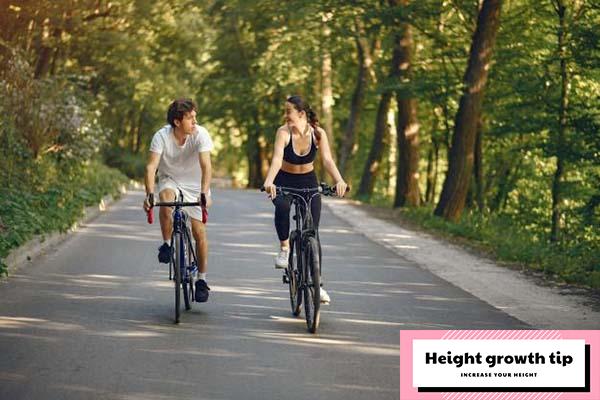
Cycling can potentially contribute to the elongation of the vertebrae, create space for cartilage growth, and support height increase.
During cycling, there is a significant impact on the femur (thigh bone) and shin bones. In developing individuals, there are gaps at the ends of these bones where growth cartilage is located. Proper exercises like cycling can stimulate the production of new growth cartilage, while older growth cartilage mineralizes into bone. This process facilitates bone elongation and has the potential to promote height increase.
To maximize the potential benefits, it is recommended to adjust the saddle height higher than the leg length. This encourages a greater stretch to reach the pedals, which can stimulate bone growth and be advantageous for height development.
Early morning is considered an optimal time for cycling. Breathing in fresh morning air while cycling can be highly beneficial for overall health. It is advisable to choose clothing with good elasticity that fits slightly snugly to facilitate movement during cycling.
While cycling may offer potential benefits for height increase, it’s important to note that height primarily depends on genetic factors and varies among individuals. Engaging in regular physical activity, including cycling, can contribute to overall health and well-being. However, it’s important to approach the idea of height increase with realistic expectations and prioritize overall health rather than solely focusing on height.
Dancesport
Dancesport, a form of competitive dance, is experiencing significant growth in many countries, including Vietnam. This style of dance involves rhythmic movements performed to music, following strict rules and techniques. Dancesport not only provides physical exercise but also promotes mental relaxation and effective stress relief.
The dances included in Dancesport are as follows:
- Cha-cha-cha: A lively dance originating from Cuba characterized by quick footwork and syncopated hip movements.
- Rumba: A sensual and passionate dance that originated in Cuba. Rumba focuses on expressive movements, emphasizing the connection between partners.
- Pasodoble: A lively Spanish dance inspired by bullfighting, characterized by strong, bold movements and dramatic poses.
- Tango: An Argentine dance known for its passionate and dramatic nature. Tango involves intricate footwork and precise movements performed in close embrace.
- Waltz: A smooth and elegant dance performed in triple time, characterized by flowing movements and graceful turns.
- Quickstep: A fast-paced ballroom dance characterized by lively and energetic movements, often performed to upbeat music.
- Foxtrot: A smooth and sophisticated dance known for its long, flowing movements and smooth transitions across the dance floor.
- Viennese Waltz: A fast-paced waltz style characterized by rotational movements and quick turns.
- Jive: An energetic and lively dance originating from the United States. Jive features fast footwork, sharp movements, and dynamic swings.
- Samba: A lively Brazilian dance known for its energetic hip movements, rhythmical bounce, and vibrant carnival spirit.
Dancesport combines artistic expression with physical fitness, allowing dancers to showcase their skills, creativity, and musicality. It provides a fulfilling experience for both participants and spectators.
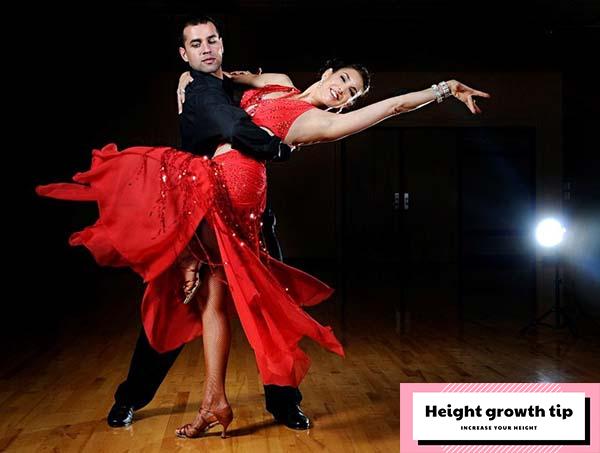
Sports dance offers various benefits for participants:
- Calorie Burning: Sports dance involves dynamic movements that require strength and speed, leading to a significant calorie burn. Regular practice helps reduce excess fat and maintain an ideal body shape.
- Increased Bone Elasticity: Sports dance training gradually increases muscle strength and force, which helps the musculoskeletal system adapt and gain flexibility. Over time, the bones become more elastic, reducing the risk of conditions like osteoporosis and bone degeneration. Sports dance is often encouraged for the elderly due to its positive impact on bone health.
- Improved Flexibility: The frequent movements, rotations, arm and leg stretches, dancing in place, and moving to music in sports dance enhance overall flexibility and agility.
- Enhanced Concentration: Sports dance requires high levels of focus as dancers must synchronize their movements with the music and maintain the right rhythm. Regular practice can improve concentration and attention to detail.
- Mood Enhancement: The presence of music in sports dance has a soothing effect on the soul and can improve mood. It helps create a sense of relaxation, comfort, and can reduce stress during and after practice.
Sports dance involves flexible footwork, various leg movements, and body bending, all of which have benefits for the skeletal system and height development. It stimulates joint cartilage development and promotes rapid bone growth.
Children as young as 3-5 years old can start learning sports dance. It is a highly artistic form of movement that combines dance with music, often performed in high heels and eye-catching costumes. If you have a passion for sports dance and want to improve your height quickly, don’t hesitate to start practicing right away.
Please note that while sports dance can have positive effects on physical health and flexibility, height is primarily determined by genetic factors and individual growth patterns. Engaging in sports dance should be approached with realistic expectations and with a focus on overall enjoyment, physical fitness, and artistic expression.
Pull up bar
Using a pull-up bar is an effective way to perform pull-ups and experience the associated benefits. Pull-ups are a challenging exercise that engages multiple muscle groups, primarily focusing on the upper body. They can contribute to improved strength, muscle development, and potentially support height development.
Here are some advantages of using a pull-up bar:
- Upper Body Strength: Pull-ups target the back, shoulders, arms, and core muscles. Regular practice of pull-ups can lead to increased upper body strength and muscle definition.
- Arm and Grip Strength: Pull-ups require significant arm and grip strength. By consistently performing pull-ups, you can enhance your arm and grip strength, which can be beneficial for various daily activities.
- Core Engagement: Pull-ups also engage the core muscles, including the abdominal muscles, to stabilize the body during the exercise. This can contribute to improved core strength and stability.
- Joint Mobility: When performing pull-ups, the joints in the shoulders, elbows, and wrists go through a full range of motion, promoting joint mobility and flexibility.
While pull-ups can be beneficial for overall fitness and potentially support height development, it’s important to note that height is primarily determined by genetic factors and individual growth patterns. Engaging in regular physical activity, including pull-ups, can contribute to overall health and well-being. However, height development is influenced by a variety of factors and varies among individuals.
When using a pull-up bar, ensure proper form and technique to prevent injury. Start with a comfortable grip and gradually increase the intensity and difficulty of the exercise as your strength improves. If you have any concerns or specific training goals, it is advisable to consult a fitness professional for guidance and personalized recommendations.
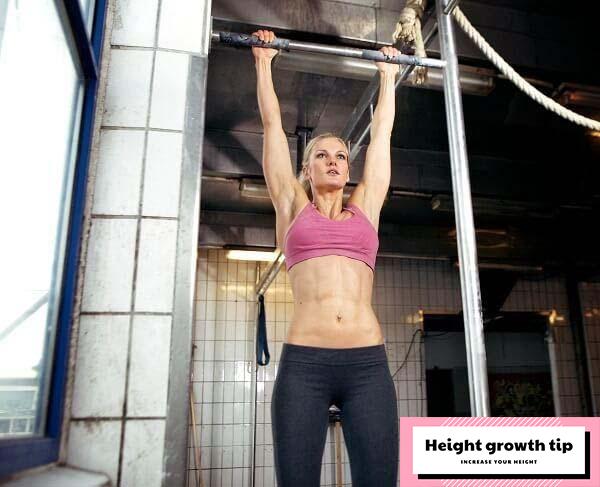
Here’s the rewritten content:
To increase height, follow these steps on how to perform barbell pull-ups:
- Warm up your muscles to prepare them for exercise.
- Stand beneath the bar and firmly grip it with your hands, ensuring that the distance between them is shoulder-width apart.
- Extend your legs, allowing your muscles and joints to stretch.
- Use your hands to pull and lift your body until your head is above the bar.
- Keep your gaze straight ahead.
- Hold this position for 3-5 seconds, then slowly lower yourself back down to the starting position.
- Repeat the lifting movement for several repetitions.
- Adjust the intensity of the exercise according to your strength level.
- Aim to perform this exercise multiple times a day whenever you have the time.
Remember to practice proper form and gradually increase the difficulty as your strength improves.
Aerobic
Aerobics is an excellent choice for individuals looking to enhance their height. Engaging in aerobic exercises set to music can induce sweating and may initially cause discomfort for those unaccustomed to it. However, the benefits it offers, including physical development, stress relief, and overall health improvement, make it a worthwhile endeavor.
Here are some key advantages of aerobic exercises:
- Improved Memory: Aerobics involves continuous movements that require participants to remember complex sequences. This aspect of aerobic exercise serves as a brain-training method, enhancing memory capacity and reducing the risk of developing conditions such as dementia.
- Weight Management: The fast-paced rhythm of aerobic exercises, coupled with intense movements, effectively burns calories and aids in weight loss. Regular aerobic exercise can help individuals achieve and maintain a toned physique.
- Increased Physical Strength: Despite initial feelings of fatigue during aerobic workouts, as individuals adapt to the intensity, their overall fitness level improves, and fatigue diminishes. This leads to increased physical strength and endurance.
- Mood Enhancement: The music accompanying aerobic exercises creates a pleasant and enjoyable atmosphere, contributing to stress reduction. By focusing on memorizing and performing the aerobic movements, individuals can temporarily set aside anxiety and fatigue, leading to improved concentration during training.
- Enhanced Sleep: Aerobic exercise consumes significant energy, promoting a greater need for restful sleep at night. Engaging in regular aerobic workouts can contribute to better and deeper sleep patterns.
Incorporating aerobic exercises into your fitness routine can yield a wide range of benefits, potentially supporting height development as well. It is important to select appropriate aerobic exercises, follow correct form and technique, and gradually increase the intensity as your fitness level progresses. Always listen to your body and consult with a fitness professional if necessary.
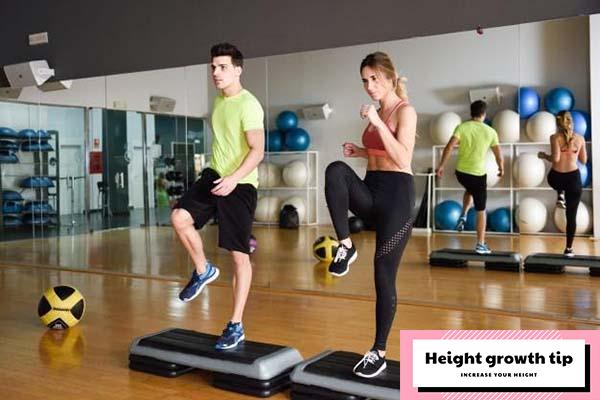
Indeed, aerobic exercises can have a positive impact on height growth. These exercises often involve full-body stretching and dynamic movements that can contribute to spine elongation. Additionally, the engagement of the legs through jumping, stretching, and other aerobic movements can stimulate new bone formation from cartilage and improve bone density, further supporting height development.
Aerobics is a versatile form of exercise suitable for individuals of all age groups, ranging from children to the elderly. Each age group can reap specific benefits from engaging in aerobic exercises, leading to improved overall health and well-being.
For children and teenagers, aerobic exercise promotes healthy growth and development, enhances cardiovascular fitness, strengthens muscles, and improves coordination and agility.
Adults can benefit from aerobic exercise by managing weight, improving cardiovascular health, increasing stamina and endurance, reducing stress levels, and enhancing overall well-being.
Even the elderly can engage in low-impact aerobic exercises that support joint mobility, cardiovascular health, muscle strength, balance, and coordination. This helps them maintain an active and healthy lifestyle as they age.
The versatility of aerobic exercises, along with their ability to cater to different age groups, allows individuals to experience numerous health benefits and contribute to a happier and healthier life
Indoor climbing
Indoor climbing has gained popularity as it allows individuals to engage in the activity while enjoying the scenery and breathing in fresh air. Despite the limitations posed by busy lifestyles and urban environments, indoor climbing offers a way to fulfill our adventurous spirit even without the natural landscape.
One of the advantages of indoor climbing is the availability of protective gear and safety equipment such as harnesses and belay systems, which minimize the risk of unexpected accidents or slips. This added safety aspect is not always guaranteed in natural climbing settings.
Indoor climbing walls provide a controlled and consistent terrain that is not affected by weather conditions. These walls are regularly checked and evaluated for safety, reducing the likelihood of risks during the exercise.
When climbing indoors, you have the advantage of being able to assess the path from below, allowing you to plan and calculate your moves in advance. This strategic approach helps optimize climbing efficiency, minimizing the time and energy expended.
Indoor climbing offers a convenient and controlled environment for climbers of all levels, enabling them to enjoy the physical and mental challenges of the sport while ensuring safety and peace of mind.
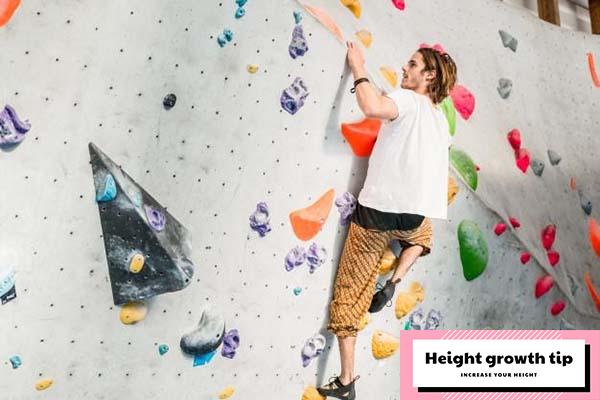
Indoor climbing offers numerous health benefits that contribute to overall well-being:
- Whole-Body Movement: Indoor climbing engages the entire body, including the upper and lower body, promoting strength, flexibility, and endurance. The back muscles, arms, and legs are actively involved in ascending the artificial walls, resulting in a full-body workout.
- Calorie Burn: Indoor climbing is a highly demanding activity that burns a significant number of calories. A single session can help burn approximately 500-900 calories, making it an effective option for weight loss and improving cardiovascular health.
- Increased Grip Strength: Indoor climbing heavily relies on grip strength, as climbers need to hold onto handholds firmly. Regular climbing training enhances grip strength, which can also have benefits for performance in other sports and activities.
- Brain Function Boost: Indoor climbing challenges climbers to think strategically and solve problems. Choosing the right handholds and foot placements requires calculation and planning, which can improve cognitive functions such as concentration, decision-making, and stress reduction.
Indoor climbing contributes to the development of muscles, bones, and joints throughout the body, promoting cartilage growth and stimulating bone growth. The intense physical activity involved in indoor climbing can also support better sleep, leading to increased production of growth hormone by the pituitary gland, which can be beneficial for height growth.
When engaging in height-increasing sports like indoor climbing, it’s important to consider the specific characteristics and requirements of the activity in relation to your abilities. Additionally, maintaining a balanced diet, getting sufficient rest, and considering the use of products that support height growth can help optimize your height potential.
